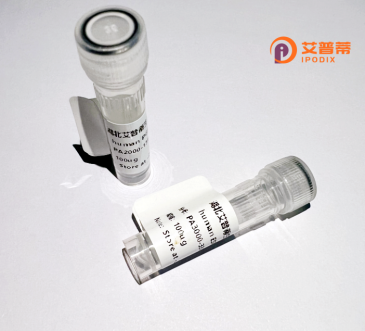
| 纯度 | >90%SDS-PAGE. |
| 种属 | Human |
| 靶点 | GSC |
| Uniprot No | P56915 |
| 内毒素 | < 0.01EU/μg |
| 表达宿主 | E.coli |
| 表达区间 | 1-257aa |
| 氨基酸序列 | MPASMFSIDNILAARPRCKDSVLPVAHSAAAPVVFPALHGDSLYGASGGASSDYGAFYPRPVAPGGAGLPAAVSGSRLGYNNYFYGQLHVQAAPVGPACCGAVPPLGAQQCSCVPTPPGYEGPGSVLVSPVPHQMLPYMNVGTLSRTELQLLNQLHCRRKRRHRTIFTDEQLEALENLFQETKYPDVGTREQLARKVHLREEKVEVWFKNRRAKWRRQKRSSSEESENAEKWNKTSSSKASPEKREEEGKSDLDSDS |
| 分子量 | 54.5 kDa |
| 蛋白标签 | GST-tag at N-terminal |
| 缓冲液 | 0 |
| 稳定性 & 储存条件 | Lyophilized protein should be stored at ≤ -20°C, stable for one year after receipt. Reconstituted protein solution can be stored at 2-8°C for 2-7 days. Aliquots of reconstituted samples are stable at ≤ -20°C for 3 months. |
| 复溶 | Always centrifuge tubes before opening.Do not mix by vortex or pipetting. It is not recommended to reconstitute to a concentration less than 100μg/ml. Dissolve the lyophilized protein in distilled water. Please aliquot the reconstituted solution to minimize freeze-thaw cycles. |
以下是关于重组人GSC(Goosecoid)蛋白的3篇代表性文献信息,内容简明概括:
---
1. **文献名称**:*Generation of recombinant human Goosecoid protein for stem cell differentiation studies*
**作者**:Li X, Chen Y, et al.
**摘要**:该研究报道了通过大肠杆菌表达系统高效生产重组人GSC蛋白的方法,并验证其在诱导胚胎干细胞向中胚层分化中的功能,证实其通过调控Wnt信号通路发挥作用。
---
2. **文献名称**:*Structural insights into the DNA-binding domain of Goosecoid and its role in craniofacial development*
**作者**:Tanaka M, et al.
**摘要**:通过X射线晶体学解析重组人GSC蛋白的DNA结合结构域三维结构,揭示其与靶基因结合的分子机制,为理解颅面发育异常相关疾病提供结构基础。
---
3. **文献名称**:*GSC overexpression promotes epithelial-mesenchymal transition in cancer cells via TGF-β pathway activation*
**作者**:Wang J, et al.
**摘要**:利用重组人GSC蛋白处理乳腺癌细胞,证明其通过激活TGF-β信号通路增强细胞迁移和侵袭能力,提示GSC在肿瘤转移中的潜在作用。
---
**注**:GSC(Goosecoid)是发育生物学领域关键转录因子,上述文献均基于重组蛋白技术探讨其功能及机制。如需具体年份或期刊信息,可提供更详细检索条件。
**Background of Recombinant Human GSC Protein**
The Goosecoid (GSC) protein is a homeodomain-containing transcription factor critical during embryonic development, particularly in establishing the body plan and regulating cell fate determination. It plays a pivotal role in gastrulation, neural crest formation, and craniofacial morphogenesis by modulating downstream gene networks. Dysregulation of GSC has been linked to developmental disorders and diseases, including certain cancers.
Recombinant human GSC protein is engineered using biotechnological platforms, such as *E. coli* or mammalian expression systems, to produce highly purified, functional protein for research and therapeutic applications. Its recombinant form enables studies on GSC’s molecular mechanisms, including its interaction with DNA and partner proteins, as well as its role in epithelial-mesenchymal transition (EMT) and stem cell maintenance.
In regenerative medicine, GSC is explored for its potential to direct cellular reprogramming or tissue regeneration. However, challenges remain in optimizing its stability, delivery, and tissue-specific activity. Current research focuses on resolving these limitations to harness GSC’s full therapeutic potential, particularly in developmental defect modeling, cancer biology, and cell-based therapies.
×